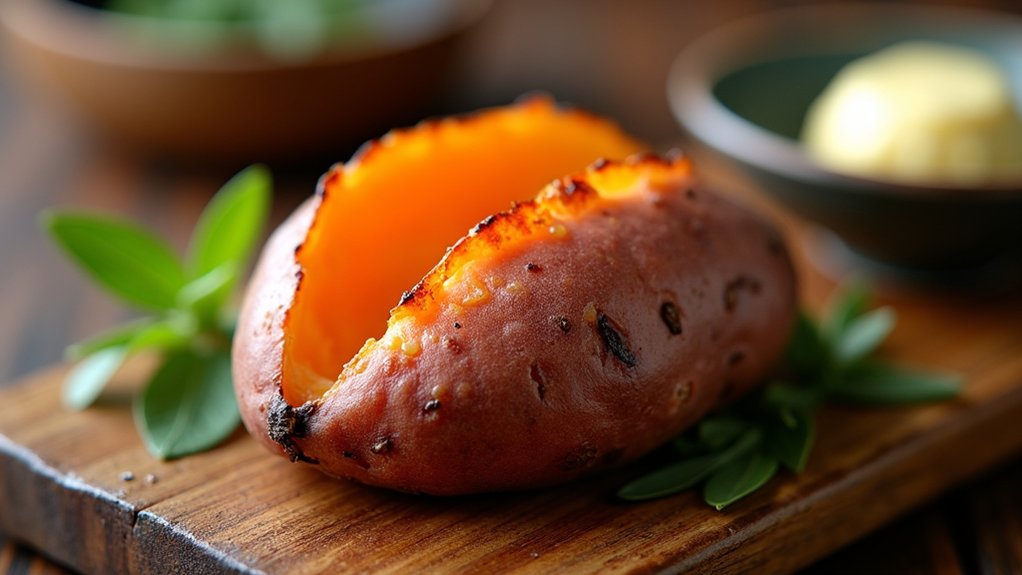Japanese Sweet Potato Recipe
If you’re looking for a delicious Japanese sweet potato recipe, you’re in for a treat! I love roasting them at 400°F for about 30-45 minutes until they’re tender and caramelized. Their sweet, nutty flavor shines in both savory and sweet dishes, from soups to desserts. Plus, they pack a nutritional punch with vitamins and fiber. If you’re curious about all the different ways to enjoy these versatile potatoes, there’s so much more to explore!
Contents
History
When I think about the history of Japanese sweet potatoes, I can’t help but marvel at their journey from ancient crops to modern culinary delights. Originating from Central and South America, these vibrant tubers made their way to Japan in the 18th century, quickly becoming a staple. Their cultural significance can’t be overstated; they’ve been embraced in festivals and ceremonies, symbolizing prosperity and harvest. Traditionally, Japanese sweet potatoes were roasted over open flames, producing a sweet, smoky flavor that still captivates palates today. As I explore their evolution, I see how innovative chefs are now reimagining these beloved roots in contemporary dishes, marrying tradition with creativity. It’s exciting to witness how they continue to inspire culinary experimentation.
Recipe
Japanese sweet potatoes, known as “Murasaki” or “Beni Haruka,” are not only delicious but also packed with nutrients. Their naturally sweet flavor and creamy texture make them a versatile ingredient in various dishes. Whether roasted, steamed, or mashed, they provide a delightful taste experience. This recipe will guide you through making perfectly roasted Japanese sweet potatoes, allowing you to enjoy their rich flavor and health benefits.
Roasting is one of the best ways to enhance the natural sweetness of Japanese sweet potatoes. The process caramelizes their sugars, resulting in a slightly crisp exterior and a soft, tender interior. These sweet potatoes can be served as a side dish, a healthy snack, or even a dessert. By following this simple recipe, you’ll create a comforting and satisfying dish that highlights the unique qualities of Japanese sweet potatoes.
Roasting Japanese sweet potatoes enhances their natural sweetness, creating a delightful dish perfect for any occasion.
Ingredients:
- 2 medium Japanese sweet potatoes
- Olive oil (optional)
- Sea salt (optional)
Cooking Instructions:
Preheat your oven to 400°F (200°C). Wash the Japanese sweet potatoes thoroughly to remove any dirt. You can choose to peel them or leave the skins on for added texture and nutrients. Cut the sweet potatoes into evenly-sized pieces or leave them whole, depending on your preference. If desired, drizzle them with a little olive oil and sprinkle with sea salt. Place the sweet potatoes on a baking sheet lined with parchment paper and roast in the oven for 30-45 minutes, or until they are tender and easily pierced with a fork. If you’re roasting whole sweet potatoes, they may take a bit longer, so adjust the cooking time accordingly.
Extra Tips:
For an even more intense flavor, consider wrapping the whole sweet potatoes in foil before roasting. This method helps them cook evenly and retain moisture. Additionally, you can experiment with different seasonings like cinnamon, nutmeg, or even a touch of honey or maple syrup for a sweeter twist. If you find yourself with leftovers, mashed Japanese sweet potatoes can be refrigerated and enjoyed in various recipes or as a filling for baked goods. Enjoy your cooking!
Cooking Steps
Let’s get started on the cooking steps that will bring these Japanese sweet potatoes to life! I always begin by preheating my oven to 400°F, setting the stage for that perfect roast. Then, I slice the sweet potatoes evenly and coat them with olive oil and seasoning, ensuring every bite is packed with flavor.
Step 1. Preheat Oven to 400°F
To kick off this delicious Japanese sweet potato recipe, I recommend preheating your oven to 400°F. This oven temperature is perfect for achieving that coveted caramelization while keeping the sweet potatoes tender inside. As I set the oven, I can already imagine the rich, sweet flavors that will develop through effective baking techniques. Preheating guarantees that the sweet potatoes cook evenly, avoiding any sogginess that might occur if they enter a cold oven. Plus, it saves time, allowing me to plunge into the next steps of the process sooner. Trust me, getting that oven nice and toasty is key to revealing the full potential of these delightful root vegetables. Get ready for a culinary treat!
Step 2. Slice Sweet Potatoes Evenly
Slicing the sweet potatoes evenly is essential for ensuring they cook uniformly. When I’m preparing them, I focus on mastering my slicing techniques to achieve that perfect, even thickness. Here’s how I do it:
- Select a sharp knife: A sharp blade makes clean, precise cuts, reducing the risk of uneven slices.
- Cut into manageable sections: I start by trimming the ends and cutting the potatoes into halves or quarters, depending on their size. This makes them easier to handle.
- Aim for uniform slices: I slice each section into rounds or wedges, aiming for about ½ inch thick. This consistency helps achieve that delightful texture.
Step 3. Add Olive Oil and Seasoning
Adding olive oil and seasoning is where the magic begins to happen, transforming plain sweet potatoes into a flavorful dish. I drizzle a generous amount of high-quality olive oil over the sliced sweet potatoes, making sure each piece gets a lovely coat. The olive oil not only enhances the natural sweetness but also helps the seasoning blend stick. Speaking of seasoning, I love experimenting with unique blends—smoky paprika, garlic powder, and a pinch of sea salt work wonders together. I toss everything in a large bowl, ensuring the sweet potatoes are well coated. The aroma that fills the air is just a hint of the deliciousness to come. Trust me, this step elevates your dish to a whole new level!
Step 4. Bake for 25 Minutes
Once I’ve got those seasoned sweet potatoes ready, I spread them evenly on a baking sheet lined with parchment paper, ensuring they’re not too crowded. This is essential for even cooking, and it’s one of my favorite baking techniques. I pop the tray into the preheated oven and set the timer for 25 minutes. During this time, I can almost taste the sweet, caramelized goodness that awaits!
Here’s what I focus on:
- Watch for golden edges: That’s when they start to turn perfectly crispy.
- Enjoy the aroma: The sweet, earthy scent fills the kitchen, getting my taste buds excited.
- Check cooking times: Adjust if needed, as ovens can vary.
This step transforms the sweet potatoes into a delightful dish!
Step 5. Flip Sweet Potatoes Halfway
As the timer buzzes halfway through the baking process, I enthusiastically pull the tray from the oven, ready to flip the sweet potatoes for that perfect caramelization. Using a gentle flipping technique, I carefully turn each potato, ensuring they’re coated in their own juices for maximum flavor. This step is essential; it allows the sugars to caramelize evenly, enhancing that natural sweetness we crave. I recommend using a spatula to avoid any mishaps and to keep the skins intact. As I place the tray back in the oven, I can almost taste the deliciousness that’s coming. Remember, flipping is more than just a step; it’s a cooking tip that elevates your dish from average to extraordinary!
Nutritional Guide
While I enjoy indulging in Japanese sweet potatoes for their delightful taste, I’m also impressed by their nutritional benefits. Packed with essential vitamins and minerals, these vibrant tubers are a powerhouse for health enthusiasts like me.
Here’s a quick breakdown of their impressive vitamin content:
| Nutrient | Content per 100g |
|---|---|
| Vitamin A | 1,000 IU |
| Vitamin C | 20 mg |
| Fiber | 3 g |
These nutrients support vision, boost immunity, and promote digestive health. Plus, their low calorie count makes them an innovative choice for anyone looking to eat healthily without sacrificing flavor. Whether baked or mashed, Japanese sweet potatoes are a delicious way to nourish your body!
Final Thoughts
Japanese sweet potatoes have truly captured my heart, not only for their unique flavor but also for their remarkable versatility in the kitchen. Their sweet, nutty taste and vibrant color add a delightful touch to any dish. Here are a few cooking tips to maximize their sweet potato benefits:
Japanese sweet potatoes are not only delicious but also incredibly versatile, bringing sweetness and vibrant color to your culinary creations.
- Roast for Richness: Roasting brings out their natural sweetness and creates a caramelized exterior.
- Mash for Creaminess: Mixing in spices or herbs can elevate your mashed sweet potatoes into a gourmet side.
- Incorporate into Desserts: Their natural sweetness makes them perfect for innovative desserts like sweet potato pie or brownies.
I hope you’re inspired to experiment with these delicious tubers. Enjoy the journey of culinary creativity!
Frequently Asked Questions
Can I Use Other Types of Potatoes in This Recipe?
Absolutely, I love experimenting with recipe substitutions! While different potato varieties can alter flavor and texture, using russets or fingerlings can create a delightful twist. Just keep in mind the cooking times may vary slightly!
What Is the Best Way to Store Leftover Sweet Potatoes?
I’ve found the best way to store leftover sweet potatoes is to let them cool, then wrap them tightly in plastic wrap or foil. This method guarantees ideal sweet potato preservation and enhances leftover storage quality.
Are Japanese Sweet Potatoes Gluten-Free?
You won’t believe how amazing Japanese sweet potatoes are! Yes, they’re gluten-free! Packed with nutritional benefits, they’re a fantastic alternative for health-conscious eaters seeking innovative, delicious options in their meals. Enjoy exploring these wholesome delights!
How Can I Tell if a Sweet Potato Is Ripe?
To tell if a sweet potato’s ripe, I look for vibrant color indicators, usually deep orange or purple. I also check for texture signs—firmness without soft spots means it’s ready for cooking and enjoying!
Can I Freeze Cooked Japanese Sweet Potatoes?
Absolutely, I’ve frozen cooked sweet potatoes before! Using proper freezing techniques, I pack them tightly to preserve flavor. Experimenting with different cooking methods first brings out their natural sweetness, making each bite a delightful surprise later.
Conclusion
So, there you have it—who knew a humble sweet potato could be such a culinary superstar? As I savored each bite, I couldn’t help but chuckle at how something so simple could bring a burst of joy and nostalgia. It’s almost ironic, right? We search for the extraordinary, yet sometimes the best delights are found in the most ordinary ingredients. So, grab that sweet potato and let it work its magic; you might just discover your new favorite dish!











